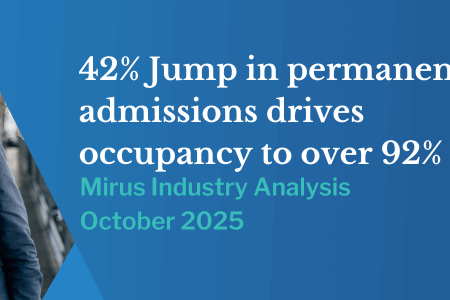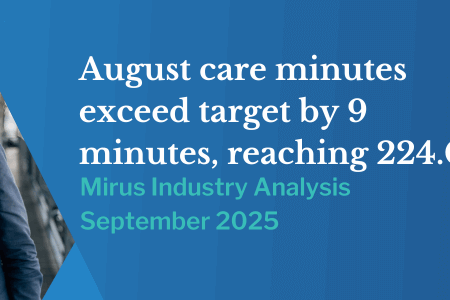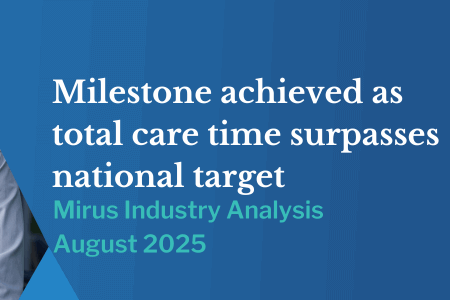How RAAFA WA meets care minute targets amid workforce challenges
August 26, 2025 | Provider Perspectives

By Dotti Gill, Marketing Manager
Managing 447 beds across five metropolitan Perth sites, RAAFA WA navigated several challenges in meeting care minute requirements under the AN-ACC framework. In our July Getting Care Minutes Right webinar, Lyn Tong, Finance Business Partner, shared how the organisation addressed challenges such as workforce shortages, regulatory changes, and EBA negotiations.
This article highlights RAAFA WA’s approach, showcasing how data, policy development, and cross-departmental collaboration have supported compliance and operational resilience.
Collaboration, data visibility and policy development
Lyn described RAAFA WA’s journey as “full of challenges,” particularly with the simultaneous negotiation of an Enterprise Bargaining Agreement (EBA) following the Fair Work Commission’s work value case.
Despite this, RAAFA WA has laid a strong foundation for care minute compliance through cross-departmental collaboration. “Everyone from finance, P&C, clinical team, hospitality, and governance is coming to the table,” Lyn said, emphasising that care minutes are an organisation-wide priority, not just a finance issue.
A critical step was improving data visibility. Initially, RAAFA WA relied on Quarterly Financial Reports (QFRs), which provided delayed insights. To address this, Lyn’s team reviewed their rostering system to ensure it captured employee time accurately across cost centres and categories, including direct care by facility and clinical managers.
“We needed data,” Lyn noted. Time-in-motion studies and staff surveys helped define roles and activities compliant with AN-ACC’s personal care worker (PCW) and direct care definitions.
RAAFA WA developed a care minute policy with support from Mirus Australia to ensure accurate time allocations. They also used scenario planning tools within Mirus Metrics to model care minute allocations and monitor potential underfunded hours. A department-led care time assessment at one site, which RAAFA WA passed “with flying colours,” provided external validation of their approach.
The organisation also built an internal care minute monitoring dashboard, pulling data on occupancy, AN-ACC classifications, and employee time to track performance fortnightly.
“This allows us to see what percentage of the target we’re achieving and potential underfunded care minutes,” Lyn explained.
Overcoming challenges: Workforce and system integration
Workforce shortages remain a hurdle, with staff often picking up extra shifts, raising concerns about burnout. “We still have a very burnt-out workforce, even post-COVID,” Lyn noted.
To address this, RAAFA WA is centralising its rostering team to better manage overtime and agency spend. “The role of the roster coordinator has grown so much,” Lyn said, highlighting the need for coordinators to understand the EBA and roster efficiently.
RAAFA WA also faced challenges in aligning admissions with care minute targets. By refining admission processes and developing tools for AN-ACC coordinators, they ensure new residents’ care needs align with facility capabilities and funding.
Lyn emphasised staff engagement, particularly when flexing rosters. “Getting staff understanding is important,” she said, noting that clear communication helps maintain morale during adjustments.
Looking ahead: Centralised rostering and revenue growth
Lyn outlined several future strategies to enhance care minute compliance. Centralising the rostering team is a priority to control unproductive labour costs, such as excessive agency use.
“It’s important to meet care minute targets, but we need to control unproductive labour dollars,” Lyn said. This includes building a reliable casual pool to cover the 20% unallocated shifts in rosters, allowing flexibility to flex up or down based on occupancy or acuity changes.
RAAFA WA is also exploring revenue growth by reviewing room prices and introducing additional service fees, responding to shifting resident expectations. “We’re looking at health and service offerings for a new generation of residents,” Lyn noted.
Additionally, the organisation is investing in a business systems and intelligence team to develop a data warehouse and dashboards for near-real-time data, enhancing decision-making. Learning and development (L&D) programs are also being expanded to engage staff in AN-ACC and care minute processes, ensuring ongoing compliance and staff wellbeing.
Key Takeaways for Aged Care Providers
- Cross-departmental collaboration: Involving finance, P&C, clinical, and hospitality teams ensures a holistic approach to care minute compliance.
- Robust data systems: Internal dashboards and time-in-motion studies provide timely insights to track and adjust care minute performance.
- Centralised rostering: A dedicated team optimises overtime and agency spend, balancing compliance with cost control.
- Staff engagement: Clear communication during roster changes maintains morale and supports a burnt-out workforce.
- Revenue and admissions alignment: Reviewing fees and refining admission processes ensures funding aligns with care needs.
RAAFA WA’s journey illustrates how providers can build resilience in the face of workforce pressure and regulatory complexity. By investing in robust systems, engaging staff, and fostering cross-departmental collaboration, they have created a strong foundation for compliance today and growth tomorrow.
You can watch the full webinar recording here.
How we can help:
RAAFA WA’s experience highlights the importance of using data and structured processes to manage care minute compliance. At Mirus Australia, we offer tools and guidance to support providers in this area. Our Care Minute Manager solution connects with your existing rostering system to provide daily visibility of your care minute progress, helping teams stay on top of compliance and make informed staffing decisions. Mirus Metrics complements this by tracking AN-ACC performance, modelling care minute allocations, and identifying potential underfunded hours. Together, these resources help providers monitor compliance and plan for future care needs with confidence.
To learn more about these solutions, request a call back.


